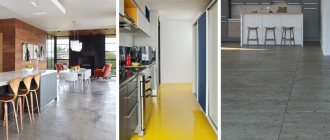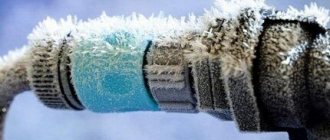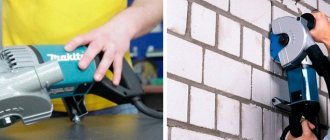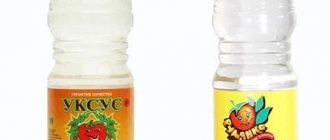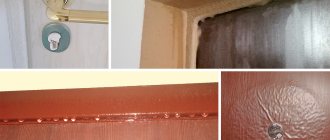How to cover a concrete floor? Concrete bases have high strength and wear resistance. However, this type of material is prone to dust formation and mechanical damage. To eliminate the possibility of rapid wear of the coating, special liquid compositions are used that protect concrete from moisture, fungal development, chemical reagents and mechanical damage. In this article we will look at the main types of impregnations and paints and varnishes that are used to treat concrete surfaces.
Why protect concrete?
The main disadvantage inherent in concrete is its susceptibility to environmental influences and its relatively short service life in the open air or in aggressive environments without the use of protective agents and proper finishing. Without proper care, this material loses its strength over time and becomes brittle - it can crack and chip, compromising the integrity of the structure of which it is the basis.
To build external structures made of concrete, it is necessary to choose the right class of concrete and select the optimal protective coating based on the construction site and its purpose. Thus, it is possible to increase resistance to mechanical and natural influences and extend the service life of products made from this material by an order of magnitude.
Useful tips
Before starting work, the moisture content of the base is checked. It is enough to glue a square of polyethylene film (40*40 cm) to the surface using tape. If the next day the base becomes wet or perspiration appears on the film, you cannot begin processing the concrete.
If the composition bubbles when applying polyurethane, it means that the layer is applied too thick or the base is excessively wet.
If the finished layer is removed with film, the technological process is disrupted - the base contains fat, is not sufficiently dust-free or is too wet.
If small debris (hairs/grains of sand) gets on the layer during work, remove inclusions with medium-grain sandpaper before applying the second layer.
When work is carried out at subzero temperatures, there must be confidence that the pores of the concrete do not contain frozen water
Types of protection of concrete from destruction on the street - what are there and which one to choose
There are only two methods of corrosion protection for concrete and reinforced concrete structures - Primary and secondary (SP 28.13330-2012)
5.1.1 Primary protection measures for concrete and reinforced concrete structures include:
- the use of concrete that is resistant to aggressive environments, which is ensured by the choice of cement and aggregates, the selection of concrete composition, reducing the permeability of concrete, the use of compacting, air-entraining and other additives that increase the durability of concrete in an aggressive environment and the protective effect of concrete in relation to steel reinforcement and steel embedded parts parts and connecting elements;
- selection and use of fittings that correspond to operating conditions in terms of corrosion characteristics;
- protection against corrosion of embedded parts and connections at the stage of manufacturing and installation of prefabricated reinforced concrete structures, protection of prestressed reinforcement in the channels of structures manufactured with subsequent tension of the reinforcement on concrete;
- compliance with additional design and design requirements when designing concrete and reinforced concrete structures, including ensuring the design thickness of the protective layer of concrete and limiting the width of cracks, etc.
5.1.2 Secondary protection measures include protection of the surface of concrete and reinforced concrete structures:
- paint and varnish coatings, including thick-layer (mastic) coatings;
- adhesive insulation;
- coating and plaster coatings;
- cladding with piece or block products;
- sealing impregnation of the surface layer of structures with chemically resistant materials;
- treating the concrete surface with penetrating compounds with compaction
- porous structure of concrete with crystallizing new formations;
- treatment with water-repellent compounds;
- treatment with drugs - biocides, antiseptics, etc.
Secondary protection against corrosion of concrete and reinforced concrete structures is used if primary protection is not enough and this may occur during the construction process or at the stage of repair of concrete structures. These are special materials (impregnations, roll and sheet materials) that are applied to the already hardened concrete surface. They are able to improve the performance characteristics of concrete structures, enhancing their ability to resist water, chemical, temperature and mechanical influences.
Components are added to the concrete mixture that increase strength, resistance to temperature changes, chemical elements, water resistance and corrosion resistance.
Find out everything about impregnations for concrete: Water-repellent impregnations as mandatory protection for concrete structures.
Preparation of materials
If you want to carry out the work competently and in an organized manner, set aside a separate corner for mixing materials. In this area, polyethylene film is spread in two layers, ensuring a change of shoes.
To work you will need:
- in order not to suffer, it is better to take ready-to-use primer for concrete;
- color paste or enamel for painting and filling. If the enamel is prepared on the basis of paste, the working ratio is taken as 1.5 paste/10 kg of varnish. The mixture is kneaded with a drill and mixer, gradually pouring the paste into the varnish. The output should be a homogeneous composition. The total kneading time is at least 5 minutes.
The mixed composition must be used in its entire volume; there should be no “dead zones” at the walls or bottom of the container.
Why does concrete deteriorate and what exactly does it need to be protected from?
5.2 Degree of aggressive media
5.2.1 Depending on the physical state, aggressive media are divided into gaseous, liquid and solid. Depending on the intensity of the aggressive impact on concrete and reinforced concrete structures, environments are divided into non-aggressive, slightly aggressive, moderately aggressive and highly aggressive. Depending on the nature of the impact of aggressive media on concrete, media are divided into chemical (for example, sulfate, magnesium, acid, alkaline, etc.) and biologically active (for example, the chemical effect of metabolic products of fungi, bacteria, physical and mechanical effects of plant roots, fungal hyphae, fouling by algae, lichens, etc.).
5.2.2 Depending on the conditions of exposure to aggressive media on concrete, media are divided into classes, which are determined in relation to specific concrete and reinforced concrete unprotected from corrosion. Classes of media indicating their indices in increasing aggressiveness are shown in Table A.1.
5.2.3 When simultaneously exposed to aggressive environments with different indices, but of the same class, the requirements relating to the environment with a higher index are applied (unless otherwise specified in the project).
5.2.4 Classification of operating environments and the degree of aggressive influence of environments on structures made of concrete and reinforced concrete are given in Appendices A, B, C and D:
- gaseous media - tables A.1, B.1, B.2;
- solid media - tables A.1, B.3, B.4, C.1, C.2;
- soils above the groundwater level - tables A.1, B.1, B.2;
- liquid inorganic media - tables A.1, B.3, B.4, B.5, D.2;
- chlorides - tables A.1, B.3, B.4, C.2, C.3, D.2;
- liquid organic media - tables A.1, B.6;
- biologically active media - table B.7.
Decorating floors with polymer coating
Glitter, chips, flocks, etc. are used to decorate floors. The inclusion of various small elements in the surface composition allows you to give the floor an original look and hide minor defects.
Particles are poured into the coating that has not yet hardened using a spray bottle or manually; the excess is removed after the floor has hardened. Next, clean the base and varnish in 2 layers.
3D floors have become very popular, which involve laying a banner film/fabric with an image on the base, and filling it with a transparent polymer coating on top. You can also lay different stones, flowers, coins, herbs, create patterns and ornaments.
All decorative elements are laid out on the base floor, then filled with a transparent wear-resistant layer. The decor can be anything - it all depends on imagination and possibilities.
How to choose the best protective coating for concrete?
The answer to this question depends on what stage the construction is at, in what region the object is located and what kind of protection needs to be done against what kind of aggression.
The best solution at the pre-construction stage would be to combine a suitable concrete composition and protective types of coatings.
If concrete with characteristics that do not ensure the resistance of the structure to aggressive environmental influences is used during construction, then in addition to primary protection measures, measures for secondary protection of the structure are provided in accordance with the requirements of SP 28.13330.2012
During the reconstruction stages, only secondary protection measures can be used. The most universal option would be coating or painting insulation (a combination of impregnating primer and paint).
The best option in terms of price-quality ratio under moderate loads and the absence of strong temperature changes would be a combination of primer and roofing felt.
If you need an option to protect concrete under special conditions - for example, with constant contact with water or chemically active substances, we recommend selecting a protective agent in accordance with the standards, based on the characteristics of the concrete structure and the aggressiveness of the environment. Below we will describe all these tools in detail.
Characteristics
Before choosing a suitable product, you need to carefully assess the condition and serviceability of the floor.
Before applying a polymer coating to a concrete floor, you should find out:
- purpose of the structure;
- type of loads exerted on the surface;
- technical condition of the monolithic floor;
- decorative design options;
- conditions under which the object is used.
Polymer paints are a powdery substance that performs the protective function of the surface material on which it is applied from the negative effects of destructive factors. In addition, some types of paints with the addition of auxiliary substances - coloring pigments, create a special aesthetic appearance for nondescript gray monolithic surfaces, giving them bright colors.
The polymer coating for concrete floors also contains the following components:
This substance is made with the addition of plasticizing components.
- dyes;
- fillers;
- solvents;
- hardeners;
- plasticizing impurities;
- products for diluting substances;
- other constituent particles.
Means for primary protection of concrete
Plasticizers, which include lingosulfonate, prevent degradation of the concrete structure under the influence of the external environment and perfectly increase the resistance of the material to mechanical loads. They are used to counteract sulfates, which are successfully neutralized and can no longer destroy the concrete structure from the inside.
Mineral additives, which include silicon, increase the strength of concrete, and electrolytic modifiers increase the rate of concrete hardening. They are often used to build foundations for residential buildings.
There are also additives of combined action that can improve several properties of concrete at once - for example, increase strength and protect metal reinforcement from rust.
Important : all products of this class are added to the concrete mixture at the stage of preparing the concrete mixture.
Major slate paint manufacturers
Rubber paint can be purchased both domestically and imported. The most popular are compositions of such brands as Farbex, Rezolux Universal, Super decor and Litex. What are the advantageous characteristics of these materials?
| Brand | A country | Paint color | Description and features |
| Farbex | Ukraine | 9 main colors and 5 additional shades, sold to order. | Purpose – decorative painting of roofing materials such as slate, ondulin, corrugated sheets, aluminum sheets, as well as any concrete, metal, wooden, plastered and other surfaces. Can be used indoors and outdoors. Can be applied to substrates previously painted with alkyd or oil-based paints. |
| Super decor | Russia | Wide range of colors (17 shades). | The composition includes pigments that prevent fading under direct sunlight. The product has an extended service life. Universal material. |
| Rezolux Universal | Russia | 8 shades including basic white. | A universal-use composition characterized by a short drying time, each layer requires no more than 30 minutes. |
| Litex | Russia | 8 shades including basic white. | The composition can withstand temperatures up to 150 degrees. Recommended for use in children's and medical institutions. |
It is important to keep in mind that some manufacturers produce highly specialized products. For example, products of the “Rubber Paint” and “Plasti Dip” trademarks are intended for painting cars and components. Therefore, before purchasing a specific composition, you should carefully study the packaging and make sure that the product is suitable for the planned activities. It is also important to study the recommendations for surface care.
Secondary protection of concrete and reinforced concrete structures
Primers
Primers are rarely used as a finishing material. Most often, they act as an internal link between the concrete and the protective coating. Penetrating primers help fill the pores in concrete, significantly enhancing its strength and increasing the overall effectiveness of moisture protection with roll or coating materials.
Another advantage when working with primers is the absence of joints and seams, making them ideal for treating large areas, providing complete surface protection. In addition, they bind all dust from the concrete, creating optimal conditions for applying a layer of protective coating. Primers are extremely easy to use - a regular paint roller will be enough to apply them, which allows you to use these materials without having professional construction skills.
Mastics
Mastics, like primers, usually form the primary or secondary layer in an insulation system. They are based on polymers and bitumen, the former are more effective in terms of resistance to temperature fluctuations and complete waterproofness, while bitumen analogues are not as effective against ultraviolet radiation and temperature changes, but significantly benefit in price. Among the undeniable advantages of using mastics, it is worth noting ideal adhesion to concrete at a relatively low price and the possibility of self-application using a roller.
Important: bitumen mastics are not recommended for use in hot climates - they can melt and lose their adhesive properties, compromising the strength and integrity of the insulating structure.
Liquid rubber
Liquid rubber combines high strength and elasticity, due to which it provides high-quality protection from water, temperature changes and mechanical damage under moderate load. The beautiful structure and large selection of colors allow this material to be used as a finishing coating.
Liquid rubber has only one significant drawback, which is the complex process of its preparation and application. You need to use special painting tools in the form of spray guns or use the pouring method to cover the concrete with it. In addition, it is necessary to monitor the thickness of the rubber layer, since if applied unevenly, its performance characteristics may deteriorate, making its independent use very difficult.
Membranes
Membranes are an ideal solution for protecting concrete roofs and objects that rarely come into contact with household chemicals. Strong and durable, they perform not only a protective, but also an insulating function. For cold climates, it is best to choose an EPDM membrane, which contains rubber and has excellent frost resistance.
The membranes are laid by soldering using construction torches, which requires special knowledge and experience, so it will be difficult to install them yourself. The disadvantages include the high price, but it is justified by the long period of operation and excellent performance of this material.
Important: all membranes are extremely sensitive to chemicals - gasoline, diesel fuel and even car oil can seriously damage this material.
Bitumen roll materials
Bitumen roll materials can serve for a very long time, maintaining excellent resistance to moisture, fire and chemical elements throughout the entire period of operation. At the same time, they have a high degree of resistance to mechanical damage. Among the disadvantages, it is worth noting the large consumption of material for joining seams (10 centimeters or more), as well as the complex installation procedure. Bitumen roll materials are installed using special construction burners, and therefore their installation requires special skills.
Important: for long-term operation, it is critical to buy bitumen roll materials based on polyester or fiberglass. If the composition contains fiberglass, then the material is suitable only as a temporary solution.
Ruberoid
Ruberoid is one of the most popular solutions with the best price-quality ratio. This is an inexpensive material that, paired with a good penetrating primer or mastic, will provide excellent protection against moisture, mechanical damage and corrosion.
The disadvantages include high consumption (to achieve the optimal effect, you need to lay at least two layers of roofing material) and an inconvenient installation procedure - bitumen is used to glue the sheets.
Pasting protective film
This material is ideal for protecting concrete from water and high humidity. It provides excellent waterproofing and is widely used in cases where the concrete is constantly exposed to water or when construction is carried out in marshy areas saturated with water. Most often used for gluing the bases of concrete structures.
The main disadvantage of such coatings is the lack of strength, but this is offset by the low price.
Paint coatings
Varnishes and paints are widely used as a finishing treatment for concrete in conditions of moderate humidity and low mechanical loads. A low price and a huge number of colors make these concrete protectants one of the most popular for treating yard structures and homes.
Before using them, it is necessary to use concrete impregnations, which will fill the pores, destroy all biological organisms and make the treated surface perfectly smooth.
The main disadvantages of these materials include a relatively short service life and low strength.
General requirements
The performance properties of the finished polyurethane floor directly depend on the preparation of the concrete base.
Recommendations for the base:
- concrete screed, humidity not more than 4 wt.%. Conditioning after installation is at least 28 days. Brand strength is not lower than M200. Evenness – deviation of no more than 2 mm along the rail;
- surface temperature is at least 2 degrees above the dew point. During operation, the temperature should not jump by more than 4 degrees;
- air and surface temperature +5 - +22 degrees;
- relative air humidity – no more than 80%;
- the temperature of the polymer and other materials is from + 10 to +20 degrees.
The room must be free of drafts, ventilation and air conditioning must be turned off . If the concrete contains seams, they are repeated on the self-leveling floor. It’s good when the lower floor has high-quality waterproofing from groundwater. It is recommended to cut off the concrete screed from vertical surfaces with a damper pad.
What is an aggressive environment for concrete?
Aggressive environment is external factors that have a negative impact on the performance characteristics of concrete. For this material, there are two types of aggressive environments:
- Liquid media
- Gas media
In liquid environments, concrete suffers from acids, sulfates and alkalis. The substances that make up the cement decompose, causing them to be washed out, forming pores. As a result, the integrity of the concrete structure is compromised and it loses its properties, becoming brittle. The liquid medium can be any natural or artificial reservoir, liquid sediments and reservoirs with any liquids.
In gaseous environments, concrete destruction occurs due to contact with carbon dioxide or vapors of caustic substances in high-risk areas. In the first case, the gaseous medium is ordinary air, and in the second case, concentrated gaseous substances in factories, factories, etc.
Aggressive environments are divided into four types, based on the concentration of substances that destroy concrete:
- Non-aggressive - permissible depth of destruction over 50 years - 1 cm for concrete structures and 2 cm for reinforced concrete ones;
- Weakly aggressive - the permissible depth of destruction over 50 years is 2 cm for concrete structures and 4 cm for reinforced concrete ones;
- Moderately aggressive - the permissible depth of destruction over 50 years is 4 cm for concrete structures and 6 cm for reinforced concrete ones;
- Aggressive - the permissible depth of destruction over 50 years is more than 4 cm for concrete structures and more than 6 cm for reinforced concrete ones.
Protection of concrete from destruction in aggressive environments
Thanks to the presence of plasticizers and external protection agents for outdoor concrete, this material can effectively serve for many years even in very aggressive environments.
In order to provide the required level of protection, it is necessary to accurately determine the aggressiveness of the chemical components that will affect the concrete and add suitable additives to the concrete mixture in advance. After pouring such concrete and hardening, it is necessary to treat the structure with a suitable impregnation and select the optimal protective coating.
One of the best means for the primary treatment of concrete by impregnation is fluorosilicate, which converts lime (the most chemically active element of concrete) into passive and durable calcium fluoride. After this, the concrete acquires maximum strength and perfectly resists most chemically aggressive substances. This composition is often used to build strong foundations and foundations for various buildings.
For external protective coatings, you need to use products that provide maximum waterproofing and resistance to chemicals. If the surface is horizontal, bitumen roll materials would be a good solution, but if it is vertical, you should pay attention to liquid rubber.
Tools and some recommendations for their use
The main set consists of affordable hand tools.
Instead of a squeegee, it is permissible to use a saw-shaped spatula
Accessories used:
- drill with a mixer attachment - I advise you to take a more powerful device, at least 1 kW. The speed change function will be useful. The mixer purchased is a double-spiral ribbon mixer. A wire mixer will ruin the batch. The approximate rotation speed for household appliances is 1000-1500 rpm, for professional ones – closer to 500 rpm;
- rake - will help identify unevenness;
- squeegee with blades R1/R2/S To increase the layer thickness, inserts with larger teeth can be used. A good squeegee will allow you to maintain the required flow rate and ensure even distribution of the composition. ;
- needle roller - this thing will serve to remove entrained air. The tool must be clean, without traces of old material, lubricants, solvents, moisture, etc. The segments of the device should rotate easily and touch the floor;
- soles with spikes – needle shoes are necessary for moving on the floor; they must be clearly fixed on the feet. Nobody canceled cleanliness and dryness either. Plus, you can’t shuffle around in your soles, otherwise the whole amount of work will be ruined;
- cleaning solvent
All tools must be clean, and before work it is necessary to check for lubrication . If there is one, they are soaked in solvent for 4-6 hours. Otherwise, defects cannot be avoided.
How to prepare concrete for applying a protective coating?
Step 1: Clean the work surface.
We remove all contaminants from the concrete using a wall sanding machine, a construction brush or coarse sandpaper.
Step 2. Cleaning from dust.
After the primer has completely dried, clean the concrete surface from dust using a construction vacuum cleaner or a damp cloth.
Step 3: Apply primer.
Apply concrete primer using a paint roller. This will strengthen the structure of concrete and clog its pores, preventing the development of microcracks and the appearance of fungi and mold. Upon completion of the work, you will have a complete and even protective layer, which is ideal for the subsequent installation of external protective equipment.
Step 4. Checking the result.
After applying the impregnation, attach a piece of polyethylene film measuring 1.5 x 2 meters to the prepared surface. It should hang for 3 days in dry weather. If no drops of water appear on the film and no wet spots appear on the concrete, you can begin applying the outer protective layer.
Step 5. Preparation of a protective agent.
We prepare the finishing material according to the manufacturer's instructions;
Expert tip: When using several products for internal and external concrete protection, it is best to buy them from the same manufacturer. This way you can achieve maximum effect.
Step 6. Applying a protective agent.
Direct application of the selected protective coating is carried out according to the technology for this material. In the case of liquid protective coatings, it is necessary to concentrate on the uniformity of the applied layer, and in roll and sheet versions, you need to take care of the correct laying technology and processing of joints.
Tools and materials required for preparing and processing concrete:
- Sanding machine or any other abrasive material;
- Construction vacuum cleaner;
- A piece of polyethylene measuring 1.5 x 2 meters;
- Adhesive tape for fastening polyethylene;
- Sprayer or atomizer;
- Construction scales;
- Shovel;
- Construction hair dryer;
- Paint roller;
- Building level;
- Construction knife.
Additional equipment for laying roll and sheet finishing options:
- gas burner for fusing bitumen roll materials
- worker personal protective equipment
Sealing joints on concrete bases
The protection of mineral coatings consists not only of additional surface treatment with reinforcing compounds, but also of sealing the seams. Special mixtures help prevent moisture from entering vulnerable areas of the structure, which has a beneficial effect on the service life of the entire floor. What is a sealant and why is it needed?
Sealants help prevent moisture from entering vulnerable areas of the structure.
Sealant is a protective liquid composition with water-repellent properties, which is used to seal seams on mineral substrates. It may contain various components that affect the technical characteristics of the mixture. The greatest demand is for rubber and polyurethane sealants, the water absorption coefficient of which does not reach 1.5%.
For what purposes are polyurethane and rubber sealants used?
- Sealing microcracks and seams on mineral coatings;
- Installation of expansion joints in the coating;
- Sealing joints formed as a result of vibrations.
Rubber joint coating is an indispensable assistant when repairing concrete floors outdoors. The hardened sealant practically does not allow moisture to pass through and prevents the appearance of fungus at the joints.
What is an anchor sheet and when is it needed?
An anchor sheet is a thick polymer film that lies on top of the concrete coating and provides the maximum degree of protection against water and aggressive chemicals that classic protective finishes cannot cope with. When fastening such sheets, special extrusion welding is used. It provides the most durable and airtight seams, guaranteeing the reliability and durability of the coating.
Anchor sheets do not lose their properties when deformed and exposed to high and low temperatures. They are absolutely resistant to water and are not subject to corrosion or abrasion. High smoothness ensures maximum permeability of water and liquids, which is why this material is often used when installing pipes.
Such sheets are used in chemical plants, water reservoirs, pipelines, sewer systems and in places where complete repair of concrete structures is impossible and maximum protection from water or other liquids is needed, for example in the foundations of historical structures that are often subject to destruction by water.
Installing anchor sheets requires special knowledge and cannot be done at home. It is carried out in several stages:
- First, the sheet is cut into the required pieces according to the drawings of the object.
- After this, it is inserted into the structure using formwork or other devices so that there is free space between the surface of the sheet and the concrete.
- Concrete is poured into the remaining space.
- The joints are welded using extrusion welding.
If it is necessary to seal cracks, sinks, putty
The stage is implemented after priming. Before applying the polyurethane layer, you should make sure there are no seams or cracks . The work requires a spatula up to 600 mm wide, with a smooth edge that fits tightly to the floor. If there is a gap of even 1 mm, you should use a tool of smaller width.
Sequencing:
- seams and cracks are removed from dust using a powerful vacuum cleaner;
- the recesses are treated with impregnate;
- Polyurethane enamel is mixed with filler to form a thick putty. It is recommended to use 2 parts of dry sand of a fraction of 0.15-0.3 mm and 1 part of dusty quartz (marshallite);
- the surface is puttied;
- after 6-12 hours the floor is rubbed (sanded). Sanding continues until streaks from the spatula are removed;
- The floor is removed from dust using an industrial vacuum cleaner. The brush should fit tightly to the floor, ensuring maximum dust suction;
- Drying conditions depend on the climatic parameters of the environment.
Drying is carried out before painting. Time – 6-10 hours, but no more than a day.
What is a hydrophobic composition and what is it used for?
Hydrophobic agents enhance the water-repellent properties of concrete and create a dense, elastic film on its surface. This film retains water and prevents it from getting inside, preventing the leaching of cement and the appearance of harmful bacteria.
This coating is resistant to temperature changes, rain, snow and fading in the sun. It can be used as a basis for the use of waterproofing protective coatings to enhance their effectiveness.
The hydrophobic composition can also be used as an independent protective material for external concrete buildings - it perfectly protects the facing material and preserves the aesthetic beauty of the walls, making it impossible to apply graffiti.
Based on the method of application, there are three types of water-repellent compounds:
- External - only surface treatment of the product is carried out. This method will improve the water-repellent properties of concrete for 25-40 years.
- Volumetric - water-repellent materials are added to the concrete mixture before the stage of creating the solution - this method allows you to achieve a water-repellent effect throughout the entire volume of the product, and even if the outer layer is erased or chipped off, the structure will retain its hydrophobic properties.
- Combined - both types of processing are carried out. This is the most reliable and expensive method of treating concrete, which provides maximum waterproofing.
Based on the forms in which water-repellent compounds are produced, they are divided into the following types:
- Paste - before use, the material is diluted with water.
- Liquid - can be used immediately.
- Powder - requires the mandatory use of a special solvent.
Classification based on:
- Silicate-based products provide the best effect and do not leave marks on the concrete surface.
- Water-based products are more resistant to fading in the sun and are cheaper than silicate analogues.
- Solvent-based products enhance the color of the surface and penetrate the concrete much deeper than options on other bases, due to which it will have water-repellent properties even if there are small chips. These products can also be used to waterproof other materials, such as exterior tiles.
All waterproofing compounds are easy to use and do not require special knowledge to work with them, so they can be applied independently. All you need is a paint roller.
Installation of self-leveling polymer floor
To install a self-leveling polymer floor, it is necessary to follow the technology and sequence of actions.
The main stages of laying a polymer self-leveling floor:
- Preparation of the base - cleaning, filling minor defects, leveling, removing dust and dirt, grinding the surface. If the floor is applied to a fresh coating, you must wait 28 days after pouring.
- Primer for concrete base - you can add fine quartz sand to it, which will improve adhesion. When the primer is applied, wait a day and remove the remaining sand with a vacuum cleaner.
- Arrangement of the base layer of the self-leveling floor - the prepared solution is simply poured onto the surface, a squeegee is used to distribute it, and air bubbles are removed with a needle roller. It is best to perform work at an ambient temperature ranging from 5 to 25 degrees Celsius.
- When the base layer has dried, a thin finishing layer of polymer is poured. There are mixtures that do not require this stage.
What do you need to know and consider when choosing a protective material for concrete outdoors?
First of all, it is necessary to take into account the operating environment of concrete products and its aggressiveness in relation to the brand of concrete that was used or will be used in their construction. This will allow you to determine the type of finish needed and properly prepare the concrete before using it.
The location where the protective coating is applied is also of great importance when choosing it - liquid products are suitable for vertical surfaces, and it is preferable to use rolled materials for horizontal surfaces.
Expert comment : when processing concrete blind areas, facades and foundations of residential buildings, it is necessary to pay attention to the safety of the chosen protective coating for human health. This is especially true for paint and varnish coatings.
Planned loads also determine the choice of certain protective materials - in case of strong mechanical stress, preference should be given to protective coatings designed for flooring and resistant to high mechanical loads.
Safety precautions when working with protective materials for concrete should include all personal protective equipment for the worker, especially:
- When working with liquid products, always use a respirator to protect your respiratory tract.
- Wear tight clothing and gloves when handling the spray bottle.
- Use construction glasses to protect your eyes when removing contaminants from concrete.
- When working with gas burners, follow safety precautions for using open flames.
- When preparing any solution, follow the manufacturer's instructions and never replace components (for example, solvents) with those that differ from those specified by the manufacturer.
Scope of application
The coating is successfully used in various types of premises.
The most common of them include:
- logistics, production facilities, terminals, warehouses;
- food industry workshops where wet technological processes are implemented;
- parking lots, car services, workshops of transport enterprises with high loads;
- children's premises;
- areas for medical purposes;
- offices;
- machine rooms, laboratories, communications, electronics factories, freezers.

